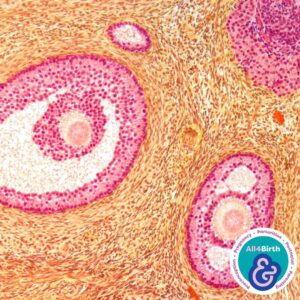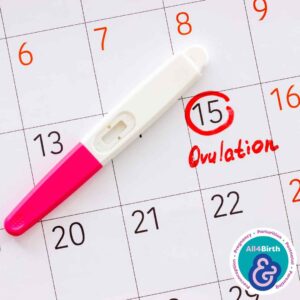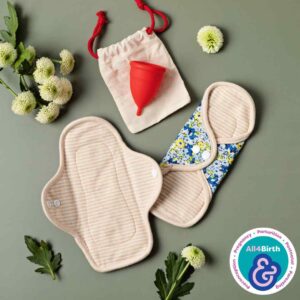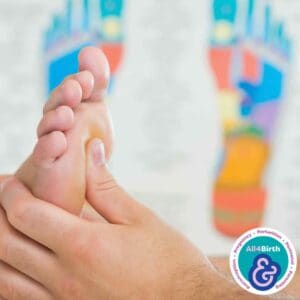Charting the Path to Parenthood: Understanding the Basics of Fertility Charting and Temperature Tracking
Abbie Tomson
Midwife MSc, BSc, Yoga Teacher, Project Lead at All4Birth
@enevlorel
Embarking on the journey to parenthood often involves understanding the intricacies of the menstrual cycle and pinpointing the fertile window for optimal conception. Fertility charting and temperature tracking are valuable tools in this process, offering valuable insights into a woman’s reproductive health. In this article, we’ll delve into the basics of fertility charting, explore the significance of temperature tracking, and guide you on how to embark on this empowering journey.
Understanding Fertility Charting
What is Fertility Charting?
Fertility charting involves tracking various aspects of the menstrual cycle to identify the fertile window—the period when conception is most likely to occur. This method allows individuals and couples to understand ovulation patterns and optimise their chances of conceiving.
Key Components of Fertility Charting:
- Basal Body Temperature (BBT): refers to the body’s resting temperature and plays a crucial role in fertility charting. A woman’s BBT slightly increases after ovulation due to hormonal changes. Tracking this temperature shift helps identify the fertile window.
- Cervical Mucus Changes: Monitoring changes in cervical mucus consistency and appearance is another essential aspect of fertility charting. As ovulation approaches, cervical mucus becomes more transparent, slippery, and stretchy, resembling egg whites.
- Menstrual Cycle Length: understanding the length of your menstrual cycle is fundamental to fertility charting. The cycle begins on the first day of menstruation and ends on the day before the next period begins.
Basics of temperature Tracking
Why track Basal Body Temperature?
Temperature tracking involves taking your BBT at the same time every morning before getting out of bed. The primary purpose is to detect the subtle rise in temperature that occurs after ovulation.
Here’s a step-by-step guide on incorporating temperature tracking into your fertility charting routine:
- Choose a Basal Thermometer: Invest in a basal thermometer specifically designed to provide accurate readings for temperature tracking. Regular thermometers may not detect slight changes in BBT.
- Establish a Routine: Take your temperature at the same time every morning, preferably before any physical activity or getting out of bed. Consistency is key to accurate tracking. It can be really useful to have your thermometer on your bedside, so as you roll over to turn off your alarm you check your temperature! Your temperature should be taken before eating or drinking, as this can affect resting temperature. If using an oral BBT, ensure you put the thermometer under the tongue and hold it in place, keeping the mouth shut until the monitor beeps. Generally, it is best to check your temperature after 3-4 hours of continuous sleep
- Record Daily Readings: Maintain a fertility chart or use a fertility tracking app to record your daily BBT readings and other relevant information, such as cervical mucus changes and cycle days. There are several available, and they will often provide a graph for you to identify the changes to identify temperature shifts.
- Identify the Temperature Shift: You’ll observe a noticeable temperature rise on your chart after ovulation. This shift indicates that ovulation has occurred, and the fertile window has likely passed. Ideally, there will be a noticeable increase of around 0.3-0.6 degrees Celsius shortly after ovulation due to the effects of progesterone. However, it is paramount that for the most accurate results, you take your temperature consistently at the same time each day. Research suggests that reproductive hormones are largely responsible for this biphasic shift in temperature. Oestrogen, progesterone, and testosterone act directly on the warm-sensitive and cold-sensitive neurones of the preoptic anterior hypothalamus 1, 2
- Track Menstrual Cycle Trends: Over time, analysing your fertility charts can reveal patterns and trends in your menstrual cycle. This information is valuable for predicting future fertile windows and understanding your reproductive health.
The MONARCH study 3 involved 58 women who were actively trying to conceive, and they contributed a total of 271 menstrual cycles to the analysis. The study demonstrated that a digital fertility monitor incorporating BBT measurements was effective in predicting ovulation and identifying the fertile window. The combination of BBT with other fertility awareness signs enhanced the accuracy of fertility predictions. Additionally, the digital monitor was well-received by participants in terms of usability, and it showed promise in early pregnancy detection. It’s important to note that individual experiences may vary, and these findings highlight the potential of integrating technology and various fertility awareness methods for those trying to conceive. Another recent study 4 involved 136 eumenorrheic (regular menstrual cycles), non-pregnant women. Participants wore wrist skin temperature (WST) biosensors during sleep and reported their daily activities and at-home luteinizing hormone (LH) tests were used to confirm ovulation. The findings of this study indicate that wrist skin temperature, measured using wearable sensors, shows promise as a reliable and convenient method for tracking fertility across the menstrual cycle. The findings suggest that WST may overcome some limitations associated with traditional BBT tracking, offering a potential alternative or complementary approach to fertility awareness methods.
.
Benefits of Fertility Charting and Temperature Tracking:
- Natural Family Planning:
- Fertility charting can be used as a natural family planning method for those looking to conceive or avoid pregnancy.
- Early Detection of Ovulation Issues:
- Charting may help identify irregularities in the menstrual cycle or potential issues with ovulation, prompting early intervention if needed.
- Empowerment and Informed Decision-Making:
- Fertility charting empowers individuals and couples with a deeper understanding of their reproductive health, fostering informed decision-making on their journey to parenthood.
The Phases of the Menstrual Cycle and Associated Temperature 5
Throughout the first part of your menstrual cycle (the follicular phase), your basal body temperature (BBT) typically stays in a lower range, usually between 36.1 to 36.6 degrees Celsius. This continues until about one day before ovulation when it hits its lowest point.
After ovulation, when the egg is released, a structure called the corpus luteum starts producing progesterone. This causes your BBT to increase by 0.3–0.6 degrees Celsius, and it stays higher during the second part of your cycle, known as the luteal phase. Towards the end of the luteal phase, as the corpus luteum shrinks and progesterone levels drop, your BBT goes back to the lower range. This can happen either one to two days before or right when your period begins.
If an egg is fertilised but fails to implant in the uterus, both progesterone levels and basal body temperature return to normal before your period starts.
Conclusion
Embarking on fertility charting and temperature tracking is a journey that invites individuals and couples to connect with their bodies and gain valuable insights into the natural rhythms of conception. Whether you’re actively trying to conceive or simply curious about your menstrual cycle, these practices can be both informative and empowering. As you begin this journey, remember that patience and consistency are key, and the knowledge gained can pave the way for a more informed and confident approach to family planning.
The use of fertility tracking apps has become increasingly popular, allowing individuals to input BBT data, track menstrual cycles, and receive predictions about fertility windows. However, the accuracy of these apps can vary, there are some suggestions of apps in the resources section, although they are not tried and tested by us at All4Birth but have been found popular amongst those with menstrual cycles.
*It is also very important to note that while tracking your temperature can help aid those trying to conceive by tracking a cycle, the mechanism does not protect an individual from sexually transmitted infections or unwanted pregnancy*
Links to resources
 Articles
Articles
Periods and Fertility in the Menstrual Cycle | NHS
Menstrual Cycle and Getting Pregnant | Tommy’s
 Books
Books
It Starts with an Egg | Rebecca Fett
Taking Charge of Your Fertility | Toni Weschler
 Film Audio and Apps
Film Audio and Apps
- Fertility Friend: Fertility Friend is a widely used app that allows users to track BBT, cervical mucus, and other fertility signs. It offers charting tools and provides insights into ovulation and fertility windows.
- Clue: Clue is a comprehensive period and ovulation tracker app. It allows users to log BBT, cervical mucus, menstrual flow, and other symptoms. The app uses machine learning to provide personalized predictions.
- Kindara: Kindara is known for its user-friendly interface and detailed charting options. It supports BBT tracking, cervical mucus observations, and other fertility indicators. Kindara is often used for both fertility tracking and natural family planning.
- Ovia Fertility & Cycle Tracker: Ovia offers a fertility and cycle tracking app that includes BBT tracking, menstrual cycle predictions, and personalized insights. It also provides health tips and educational content.
- Natural Cycles: Natural Cycles is a contraceptive app that uses BBT tracking as the primary method. It is designed for both conception and contraception, and it provides users with a daily fertility status based on their temperature data.
- Eve by Glow: Eve is an app by Glow that combines period tracking with community features. Users can track BBT, cervical mucus, and other symptoms while connecting with others in the Eve community.
- Flo Period & Ovulation Tracker: Flo is a popular period and ovulation tracker that allows users to log BBT, symptoms, and other health information. It uses artificial intelligence to provide cycle predictions.
 Websites
Websites
References
- Nakayama, T., Suzuki, M., & Ishizuka, N. (1975). The action of progesterone on preoptic thermosensitive neurones. Nature, 258(5530), 80. https://doi.org/10.1038/258080a0
- Silva, N. L., & Boulant, J. A. (1986). Effects of testosterone, estradiol, and temperature on neurons in preoptic tissue slices. The American journal of physiology, 250(4 Pt 2), R625–R632. https://doi.org/10.1152/ajpregu.1986.250.4.R625
- Werner, M. D., & Kobe, C. J. (2017). Monitoring of Fertility and Early Pregnancy in the St. Petersburg–Tampa Bay Area (MONARCH). PLoS One, 12(10), e0186052. https://doi.org/10.1371/journal.pone.0186052
- Shilaih, M., Goodale, B. M., Falco, L., Kübler, F., De Clerck, V., & Leeners, B. (2018). Modern fertility awareness methods: wrist wearables capture the temperature changes associated with the menstrual cycle. Bioscience reports, 38(6), BSR20171279. https://doi.org/10.1042/BSR20171279
- Weschler, T. (2016). Taking Charge of Your Fertility: The Definitive Guide to Natural Birth Control, Pregnancy Achievement, and Reproductive Health. Random House












